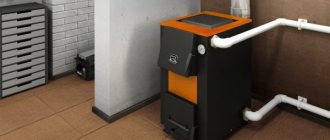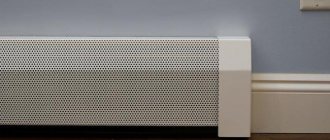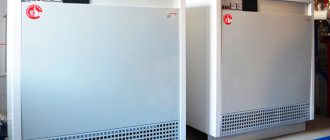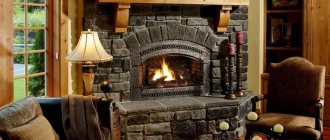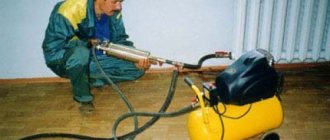Fast passage:
- Type of air conditioning system of the cottage
- Duct air conditioners
- Multi-zone conditioners
- Inverter types of air conditioning systems
- Central air conditioning system of the "chiller - fan coil units - individual heating point" type
- Systems with variable volume and temperature of the air supplied to the premises
- Split systems and multisplits
- Installation of air conditioning systems
How do I get a commercial offer?
Prom Klimat is a professional design and installation company. We implement engineering systems of a building or premises at your facility on a turnkey basis. Send your applications by email or call by phone, and our engineer will prepare you our commercial offer.
It is best to plan air conditioning in a cottage even at the construction stage, when there is a possibility of communications. The air conditioning system will cost less; the finishing will not be disturbed during the installation process.
The choice of air conditioners for a cottage rests on three indicators:
- a type;
- power;
- brand.
Type of air conditioning system of the cottage
The most popular types of climatic equipment are:
- wall split systems, including multisplits;
- duct air conditioners;
- multi-zone systems.
Wall mounts are an inexpensive way to air condition a cottage.
But for a multi-room house, it is not the most convenient. After all, each room will have to install its own air conditioner.
Multisplits - there are several indoor units for one outdoor unit. That is, you can get by with one air conditioner for a medium-sized cottage. The equipment works quietly, the main noise is from the outdoor unit, which is mounted outside. The air temperature in each room can be set differently. Up to 9 indoor units can be connected to one outdoor unit.
What types of air conditioners are suitable for a private house
The choice of an air conditioner for a private house depends on the preferences of the owner - but only two types of devices are most suitable, which we will talk about below. More often, buyers choose wall split systems.
Wall split systems

Compact wall-mounted devices are practical, conveniently located, have an affordable price and are ideal for air conditioning in one room or in a specific area of the house. These air conditioners fit into the interior of any room.
A typical split system for a home consists of an outdoor compressor and an indoor unit. The market offers a wide range of models of HVAC equipment at different prices, so you can choose a model in accordance with your requirements.
Experienced installers install and run the system within 3-4 hours. All that is required for the installation of wall "conduits" is available only from specialized companies. But before buying a device in large supermarkets, check all the nuances of installation (what materials are included in the price and how professional the installers are).
Duct air conditioners


Very rarely, such systems are installed in houses, but if the height of the ceiling allows and you really want to get rid of indoor units, then you can install channel air conditioners. Their indoor unit is usually located in the ceiling or attic, the outdoor unit in a suitable location outside the house. The conditioned air circulates through the duct network from the indoor unit with exits to rooms where only ventilation grilles or anemostats are visible. Temperature and operating hours are monitored by the control panel. But duct devices are much more expensive than wall split systems.
Duct air conditioners
Ducted air conditioning systems for cottages are widely used in America and Europe. The indoor unit is built under the false ceiling, ventilation ducts are distributed from it throughout the house.
The advantage of the systems is the ability to mix fresh air from the street, while simultaneously providing ventilation of the premises. The system serves several rooms.
Ducted air conditioning systems in cottages have only one significant drawback: additional expenses for broaching ventilation ducts.
Wall-mounted air conditioners
Wall-mounted units are installed directly in the room where it is necessary to regulate the air temperature. Split systems consist of two units (indoor and outdoor) connected by a technical hose for air and refrigerant circulation.
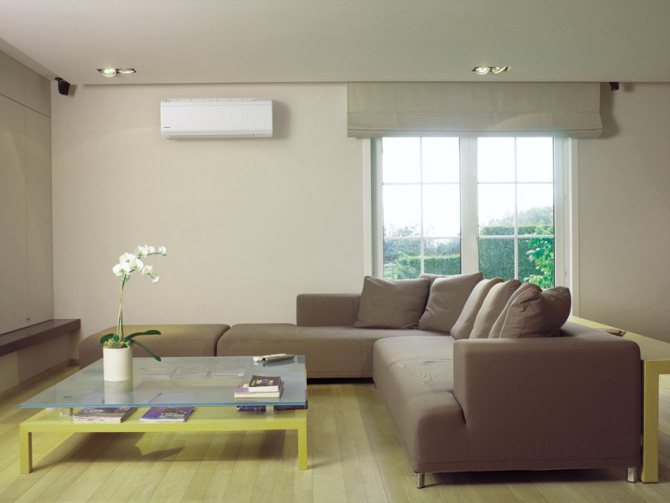

Benefits:
- low cost
- large set of functions
- can be installed at any time - practically does not harm the decoration of the room
- High system reliability, easy repair and maintenance.
disadvantages:
- maintenance of only one room
Among the split systems, the division of equipment into classes is best traced.
- Economy class split systems provide only basic functions - cooling and heating.
- The middle level is usually offered by bona fide manufacturers without a big name. The split system works reliably and may have additional options.
- Elite split systems can last more than 10 years. There are many additional functions available.
Multi-zone conditioners
Optimal comfort in a large country house will be provided by multi-zone air conditioners. The biggest advantage of this air conditioning method in cottages is the ability to lay long communications between the modules. Therefore, outdoor units can be installed in any convenient place.
Several dozen indoor units are connected to one outdoor unit, which can be of different types (wall-mounted, cassette). At the same time, they can simultaneously warm some rooms and cool others, which is not possible with other air conditioning systems.
The temperature drops in the premises are only 0.5 degrees, which is impossible to provide with other types of climatic technology.
Multi-zone systems simultaneously heat, condition and ventilate the premises. However, they consume less electricity than other systems of similar power.
Choosing an air conditioner in a country house, cottage
It all depends on the budget. We will create whatever you want with prices below the market average, you are not ashamed of that.
As a rule, in 80% of air conditioner installations in country houses and cottages, the scheme of the following plan is chosen: one powerful split system in the hall and one split system in two or three bedrooms. In this case, the air conditioner, which is located in the living room, is selected with a power reserve, because often it is an open-space and the living room itself flows smoothly into the kitchen and we have several exits to the corridor, stairs to the second floor. The air conditioning systems themselves are installed in country houses, as a rule, at the stage of renovation, when there is a real opportunity to hide communications under the final finishing.
The most common question is: how much does an air conditioner cost for a cottage?
From a wall-mounted split system at 20,000 rubles. to engineering systems of channel air conditioning with fresh air supply, purification and humidification costing 200,000 and 700,000 rubles. It all depends on your technical task, needs and capabilities, budget. And we will help! This is our job.


Installation of an air conditioner in a country house
An example of work on the installation of air conditioners in two stages in a country house
To the object


Multi-zone air conditioning of the cottage
VRV Daikin with cassette air conditioners in a cottage under renovation
To the object
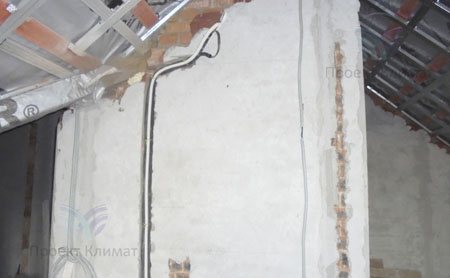

Route laying at the stage of repair
Strobing and laying a freon line for air conditioners
To the object
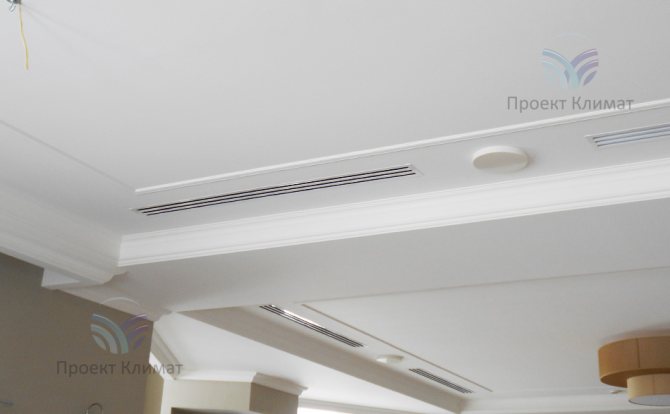

Ventilation, air conditioning humidity control
Complex equipment of the cottage with systems
To the object
Also, in the overwhelming majority of cases, a multi-split system, VRF / VRV system or channel air conditioner is chosen as an air conditioning system for a cottage. The main advantage of this step is the presence of only one outdoor unit: there is no need to clutter the facade of the building or the backyard with several outdoor units of air conditioners.
About duct air conditioners
Multi split systems
Multi-zone air conditioning
Multisplit system
characterized by the fact that routes from all internal ones located in different rooms are brought to one external block. At the same time, indoor units can be not only of different cooling capacity, but also of different types (wall, floor, duct, cassette). Installation of a multisplit system costs a little more than several independent split systems, even though the cottage is air-conditioned using one outdoor unit. But there is no heap of "birdhouses" on the facade of the house.
Duct air conditioners
- this is also one outdoor unit and one indoor unit, but from the indoor unit, the already cooled air is wired through heat-insulated air ducts around the premises.
Multi-zone VRF / VRV system
- this is the same multisplit system capable of changing the amount of refrigerant supplied to the line. As a rule, this is a sufficiently powerful external unit capable of cooling a country house of hundreds and even thousands of square meters. Indoor units are also selected separately, based on the layout of the building and technical specifications. However, there are also small, multi-zone air conditioners, specially designed for the air conditioning of relatively small (from 150 to 600 m2) areas.
Installation of a multi split in a cottage under renovation
Installation of ventilation and duct air conditioning
It is advisable to be puzzled by the installation of air conditioners at the stage of general construction and repair work in the cottage. At this stage, it is still possible to lay all communications hidden (in a groove made along the wall or under the ceiling), drain the drainage into the sewer, and not onto the street. The installation of a duct air conditioner unambiguously implies the installation of air ducts, air heaters, grilles with valves and electric drives to them at the repair stage: it is basically impossible to install all the fittings for finished repairs.


Inverter types of air conditioning systems
In simple terms, inverter models of air conditioners can regulate the operation of the compressor motor and create an optimal temperature regime in the room. It is the speed of rotation of the engine that makes it possible to effectively cool or heat the air masses.
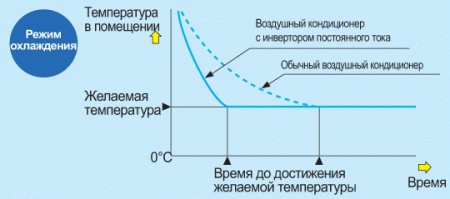

Benefits of inverter systems:
- multifunctionality;
- quick response to changes in functions;
- automatic creation of the optimal temperature regime;
- ventilation of the room with fresh air;
- ionization of air masses;
- low level of consumption of electrical energy.
The functions and properties of such air conditioning models are orders of magnitude higher than standard split systems. We can say that they are also split systems, but with great capabilities and functions. Compressors in inverter models are standard, which means that the amount of electricity consumed will be low, which will make it possible to constantly use such an air conditioning system. In the event of a breakdown, it is better to contact a professional.
It is possible to use an inverter-type air conditioner in winter. Only there is a certain temperature maximum, which will not allow the equipment to be operated at -10, -15 degrees of frost.The systems have adjustable blades, which makes it possible to direct the air flows in the desired direction.
Advice. Inverter air conditioners are best mounted in any corner. Thus, the flow of air masses will be carried out in a circle.
Inverter air conditioning systems always have a beneficial effect on the indoor climate. Today there are different types of inverter split systems. They make it possible to connect several internal units to one external unit. As a rule, the maximum number of such connections does not exceed 5 pieces of indoor units.
Other alternatives to climate technology
Multi split systems are several indoor units that are connected to one outdoor unit. They are usually


used in houses with a non-standard layout, where the owners do not want to have several outdoor units throughout the house. Indoor units work independently of each other (the temperature in different rooms can be adjusted differently). The price of multi-systems is much more expensive than conventional air conditioners. Their installation is also very expensive. Therefore, it is much more convenient to put separate splits in each room.
- Floor standing air conditioners are usually purchased for temporary use. It is easy to carry it from room to room, take it with you to the dacha. These models are especially popular with rental housing owners. Modern floor-standing air conditioners have adjustable or automatic modes for setting the desired temperature, but in comparison with wall-mounted "splits" they are in many ways inferior to the latter.
- Window devices were once very popular but are now outdated. They can still be found on sale, but they are not in demand.
Other types of air conditioners are practically not used in homes.
Air conditioners are sold in specialized companies, in the departments of household appliances in hypermarkets and in online stores. The first option remains the most correct for the purchase, as it allows you to get a competent selection and high-quality installation. You can ask the managers questions and, on the basis of this, decide which air conditioner to buy for your home.
Central air conditioning system of the "chiller - fan coil units - individual heating point" type
Central air conditioning systems are used to heat a cottage at any outdoor temperature, as well as to cool, heat and clean the air from dust. In principle, it is possible to combine such systems with supply ventilation units, however, in practice, it is customary to organize air exchange in cottage rooms using supply and exhaust systems independent of the air conditioning system.
The fencoil system has a number of advantages of VRV systems, as well as very low inertia and configuration flexibility. It can be used to condition the air in a building with any number of rooms. In air-conditioned rooms, special devices are installed - fan coils, similar to the internal blocks of split systems. For cottages, floor-standing fan coils are most suitable, which are easy to place in window niches. There are also open-frame models that are mounted behind decorative wall panels or false ceilings.
Fan coil units with one heat exchanger are units of seasonal operation: in summer they are used to cool the air, and in winter - as heating devices. Fan coil units with two heat exchangers are used in universal systems that can simultaneously cool, heat or simply ventilate various parts of the house. Such a regime is necessary primarily in spring and autumn. For ease of operation, fan coils are equipped with special remote controls and an automation system that allows group control and individual control of each fan coil in automatic or manual mode.
Fencoil units are connected to cold and hot water sources or to suitably prepared non-freezing glycol. For domestic purposes, water or glycol mixture is cooled by an air-cooled chiller of a condensing unit with a capacity of 2 to 50 kW. The most modern chillers are equipped with scroll and screw compressors and have low starting currents (which is important for poor cottage wiring), as well as high efficiency. Similar to the outdoor unit of VRV systems, the chiller is installed on the roof, on the wall, in the garden or in a utility room located at any distance from the house. In regions where the outdoor air temperature never drops below -15 ° C, a chiller with heat pump mode can function as an individual heating point. This will greatly simplify the design of the fencoil system.
In the Moscow region and in other areas of active cottage construction, where the thermometer often drops below 30 ° C in winter, it is best to use a gas boiler as a source of hot water or glycol mixture, which is several times more economical than an electric chiller with a heat pump. Another source of heat is hot water from the central heating system. True, due to poor quality and high temperature, it is suitable only for indirect heating of the coolant supplied to the fencoil system.
Installation and commissioning of the system "chiller - fan coil units - individual heating point" will cost the customer approximately 25-30% of the cost of the equipment, and the simplified version - 20-25%.
Air conditioning at home
Air conditioning of a private house or cottage is an issue that should preferably be resolved even at the construction stage. We will tell you what you should pay attention to when choosing an air conditioner for a suburban building, and what type of system is better to prefer.
Features of air conditioning in a private house
When choosing an air conditioning system for a country house, consider:
- system power... This parameter is selected according to the dimensions of your building. In this case, it is worth taking into account all sources of heat, general illumination and the number of permanent residents. Because if the capacity of the air conditioning systems for the home is excessive, then the electricity will increase. And if, on the contrary, the capacity is not enough, then the air conditioner will no longer cope with the tasks set. That is why the power is calculated by experts.
- energy efficiency of the system... The higher this parameter, the more expensive the air conditioner will cost you. But at the same time, the higher the energy efficiency of the installation, the less energy consumption will be.
- type of compressor... The right solution for a cottage is an inverter compressor. This type consumes energy economically, is characterized by silent operation and smooth adjustments. If we are talking about small air conditioners for a country house, where you visit only in the summer, give preference to non-inverter installations.
- air intake function... The best option, if your house is built in an ecological place, will be the presence of the function not of filtration, but of air intake.
- exterior and interior... The split system will inevitably affect the exterior and interior of the house. Consider in advance where you will install the indoor and outdoor units. Or maybe you will install a channel or cassette system where the blocks are not so noticeable?
Types of air conditioning in a private house
Consider all types of air conditioning in a residential building and their pros and cons.
Window monoblock air conditioner
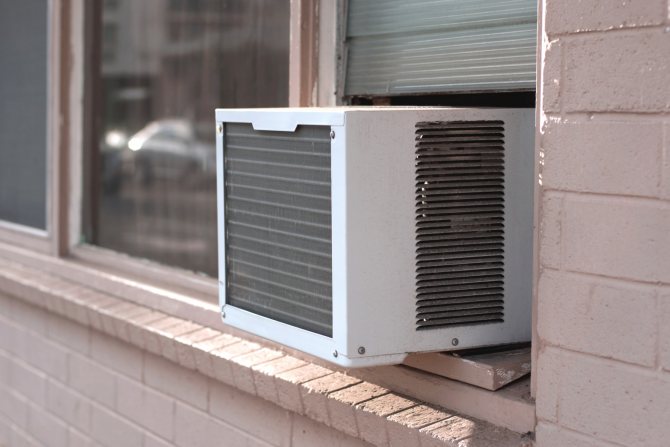

It is a single unit that is mounted in a window or doorway. It is used, as a rule, in country houses, since it is not possible to install it in the plastic windows of city apartments.
Pros:
- budget system.
- consumes a minimum of electricity.
- practical.
- easy installation.
- small size.
Minuses:
- unattractive appearance.
- there is no way to install in a plastic window.
- there is no possibility of using blinds, the illumination of the room is also reduced.
- noisy work.
- low power.
- in cold weather, cold air enters the room from the street.
Floor standing monoblock air conditioner
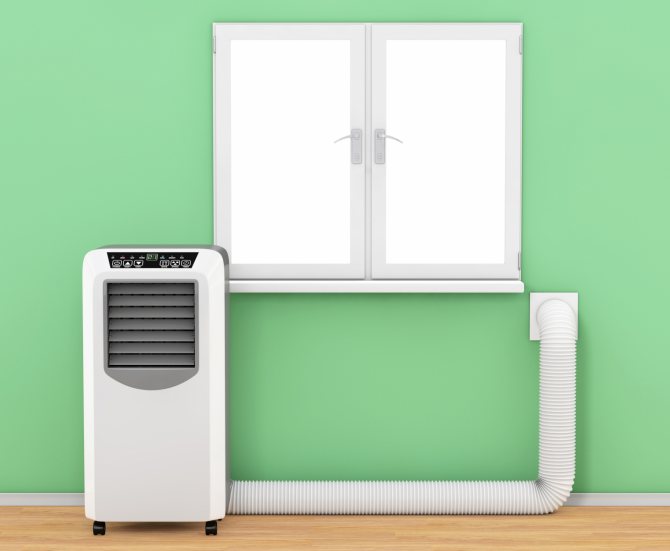

The system is a single unit with a corrugated hose that is connected to a window or ventilation. Control is carried out using a remote control. The model is not as primitive as the previous one. Also well suited for summer cottages, where the owners spend time only in the summer.
Pros:
- mobility. It is possible to transfer the air conditioner to other rooms.
- ease of installation and dismantling.
- special filters in the system will cleanse the air from dust and endow it with healthy ions.
Minuses:
- low power.
- unattractive appearance.
- the need to frequently empty a special water tank.
Floor standing monoblock air conditioner without duct


It is a single block, which for full-fledged work you will only need to unpack, put in one of the corners of the room and turn it on. Also well suited for a small country house that is used only in the summer. When the season is over, the air conditioner can be taken with you and used already in the city.
Pros:
- ease of use.
- mobility.
- small size.
- lack of installation.
- additional heating and drying functions.
- attractive design.
Minuses:
- low power.
- the need to often pour water into a special container, as well as often empty a special tank.
- the device is noisy.
- not suitable for rooms without windows and with high levels of humidity, such as basements.
- the exact temperature cannot be set.
Wall split system
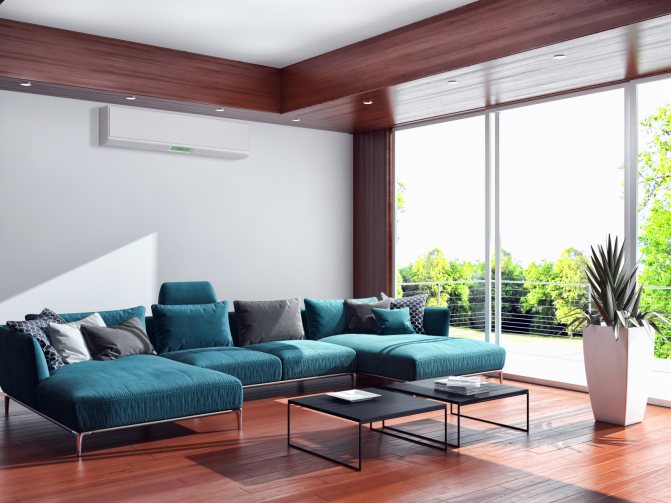

Split (split) is translated from English as separate, which is why all systems that have an indoor and outdoor unit have a prefix - split. The wall split system is the most common and most suitable for a small country house. For example, if one block is enough for you for a large living room, which is combined with a kitchen. It is best to place the block in the center of the longest wall. If there is a sofa under the block where family members like to spend time, then it makes sense to install a transparent screen so that the air flow does not interfere with the rest. When installing the unit in a bedroom or nursery, make sure that the air flow is not directed towards the bed.
Pros:
- simple control.
- heating in cold weather.
- air filtration, if necessary.
- energy saving in some models.
- air ionization in some models.
- attractive design.
Minuses:
- complex installation.
- the need for professional service.
Cassette split system
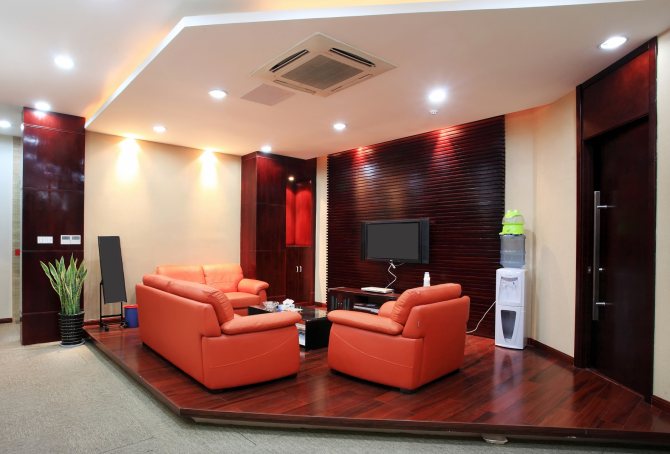

Well suited for houses that differ in their dimensions. It will support any interior, since after installation it is a system located flush with the ceiling. The size of the cassette air conditioner is 600 x 600 mm, which is the same as the size of the ceiling tiles. Central room placement is suitable for this type of home air conditioning.
Pros:
- even air flow directed to all four sides.
- ideal system for large spaces.
- silent work.
- suitable for any interior.
Minuses:
- suitable only for installation in conjunction with a suspended or stretch ceiling.
Channel split system
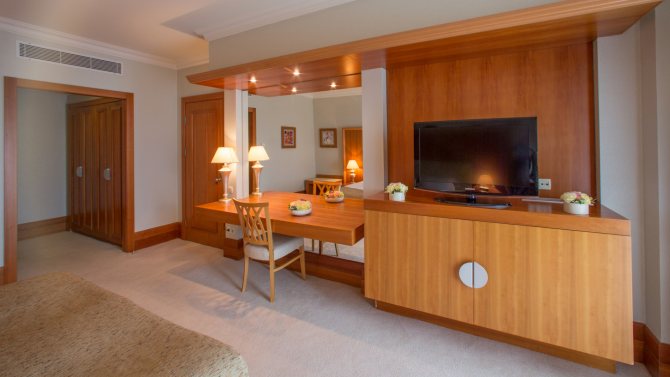

In duct systems, unlike wall and cassette systems, there is the possibility of zoning, that is, it is possible to set the desired temperature in each room separately. It is best to install such an air conditioner in an overall structure, since the system does not belong to the budget.
Pros:
- zoning (setting the desired temperature in each zone).
- the system is reliable.
- attractive grill designs that can be ordered to your liking.
Minuses:
- the system does not apply to the budget.
- installation does not differ in budget.
- the system needs professional regular maintenance.
Multi-split system
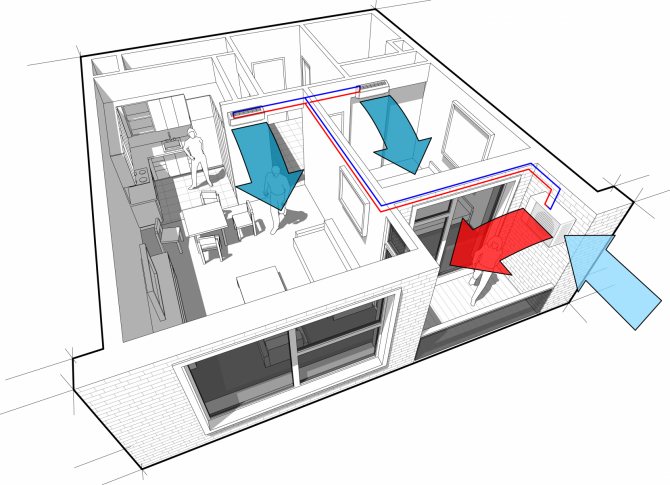

If you decide to stop your attention on wall or cassette models, but you are embarrassed that external blocks will spoil the facade of the building, pay attention to the multi-split system. The unit consists of several indoor units and a single outdoor unit.
Pros:
- only one external unit, instead of several.
- noise is produced by just one outdoor unit, not several.
- only one outdoor unit will have to be serviced (cleaning, charging with refrigerant), not several.
- both wall-mounted and cassette units can be placed.
Minuses:
- installation does not apply to the budget.
- zoning does not apply to this system. Having turned on the heating in one room, you will not be able to turn on the cooling in the other.
Multi-zone system
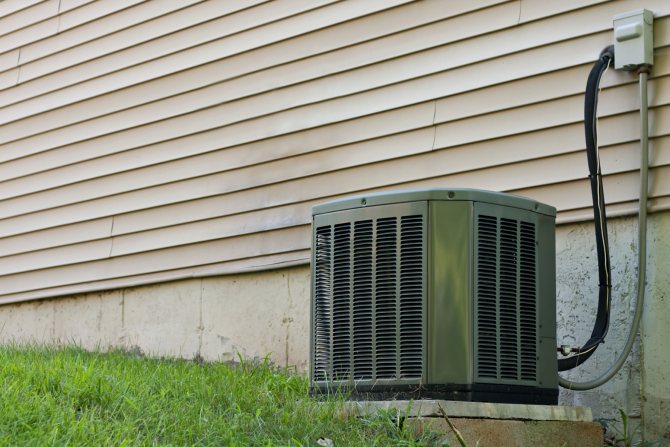

A similar system is used for apartment buildings, as well as for elite suburban housing. The fact is that such installations are characterized by the highest level of comfort during operation, and energy efficiency and noiselessness today have no analogues in the whole world. An air conditioning system for a private house may also include a ventilation unit. The system can include up to several dozen indoor units connected to only one outdoor unit. In this case, the facade of the building will not spoil the outdoor installation, since it can be placed either on the roof or in the basement.
Pros:
- aesthetics. The system does not spoil the facade, as the outdoor unit can be placed in the basement, on the roof or even at a distance from the house.
- zoning. Each room can have its own parameters for both cooling and heating.
- the system is resistant to accidents.
- multi-zone systems maintain the most accurate temperature (up to + -0.5 degrees), unlike other systems.
- if it fails, it restarts itself.
- compatible with the "smart home" system
- it is possible to combine with a ventilation system.
- durability.
- low power consumption.
- in the future it is possible to easily enlarge the system by adding new elements to it.
- practically silent.
Minuses:
- the highest cost of all air conditioning systems.
Systems with variable volume and temperature of the air supplied to the premises
The specified system is able to maintain all the main parameters of the microclimate of the premises - temperature, humidity, purity and air mobility - within the optimum values. This becomes possible due to the supply of air of a certain temperature in metered quantities to the conditioned zones. The equipment in many respects repeats the equipment of traditional air central air conditioning systems. All air processing, including heating, cooling, as well as centralized cleaning, humidification and ionization, is carried out by a roof-top air conditioner or a modular central air conditioner. Roof-top with indirect gas heating of the air flow is installed on the roof of the cottage or on the ground, next to the house, and with the help of special equipment is connected to the gas main and the power grid. The central air conditioner of modular type, which is a set of various air handling devices, is located in a special technical room. Sources of heat and cold supply for it are usually an individual heating point (boiler) and a water-cooling machine - a chiller.
The prepared air is supplied to the rooms through a network of air ducts, which are mounted above the suspended ceiling.The duct mouths are closed by ceiling linear diffusers or specially designed grilles that distribute the air extremely evenly throughout the room.
In order for air of a strictly defined temperature to enter each room, a thermostat is set in all air-conditioned zones. At the same time, several air-conditioned zones can be allocated in one large-sized room, or a number of small rooms can be considered as one zone.
The microprocessor unit controls the operation of the air conditioner (in cooling, heating or ventilation mode) and the sequence of supplying conditioned air to the premises according to the summarized data of all thermostats. As a result, the zone control valves installed in the ventilation ducts directly in front of the diffusers allow the required volumes of prepared air to pass through. The system includes gas analyzers, humidity sensors and other monitoring equipment.
Installation and commissioning of a system with a variable volume and temperature of air supplied to the premises at the proper level can only be performed by highly qualified specialists. The cost of these works can be up to 35% of the cost of a set of equipment.
Air conditioning in a cottage - why and how?
An example of installation in a country house of a split system with DAIKIN wall models
A private house: Do you need an air conditioner in a country house?
Boris Kharitonov, technical director of DAICHI: Yes I need it. First of all, because of the ventilation. Air conditioning can be roughly divided into 3 parts: ventilation, heating, maintaining the temperature regime in summer. Heating and ventilation are compulsory for modern buildings, which are built sealed (double-glazed windows, insulation, etc.). If a wooden hut was ventilated naturally, then in a "sealed" modern house you will have to take care of it yourself, and it is advisable to do this at the design stage. In turn, ventilation requires air conditioning - so that air of a comfortable temperature and composition enters the room.
- What are the criteria for choosing an air conditioning system for a country house?
- All possible air conditioning systems are suitable for the cottage. Therefore, the choice largely depends on the preferences of the owner of the house. For one, the main parameter is cost, for another - energy efficiency, the third will prefer a water cooling system, the fourth - freon, the fifth - air. Many owners dream of an understandable system: a box that processes air and air ducts through which it enters the room. But this will require fairly large air ducts - not every owner is ready to make room for a bulky and branched air distribution system. Much depends on the customer's preferences in terms of design - to hide the air conditioner, decorate it, take it 50-100 meters out of the house ... More - a lot is determined by the volume of the room. If these are 2 rooms, ordinary household air conditioners will do - splits, if 5-7 rooms - multisplits with one outdoor unit and the rest of the indoor ones. So that they are not visible, there are many design options for air conditioners - cassette under the ceiling, floor standing, wall mounted, etc.
- Almost all modern air conditioners have a heating mode. Can we count on them as a heating system and use them instead?
- I am a supporter of traditional heating. However, air conditioning can complement and improve the system. Of course, you can heat the house with air conditioning and at -20 outside the window. But I think this is unreasonable - the air conditioner consumes energy, and the efficiency at this temperature is quite low. In cold weather, I would use a traditional heating system, and in transitional periods - in spring, autumn, when it gets colder in summer - it is more convenient to use air conditioning. Both systems should complement each other and be well debugged.Otherwise, you may end up heating and cooling at the same time.
Use cases for Daikin indoor units in combination with the super-multi system RMXS To see the full diagram, click on the picture
- Is it worth humidifying the air?
- Moisturizing is good. But, in principle,. a person can feel comfortable in the range of 30 to 70% humidity, which is usually found in living quarters. A good air conditioner will not dry out indoor air. Therefore, humidification is necessary either for people with individual requirements, or when there are antiques and other things in the room that require a well-defined moisture content. Please note: when humidifying, the air conditioner must work constantly, without shutdowns. In addition, you need constant service, water treatment and, what is most unpleasant, you need a more complex project, in which the main thing will not be the owner's desire for design, but the decision of the designer, which is made according to technical capabilities.
- How much does it cost to provide air conditioning? What can you save on and what not?
- The average price of the entire air conditioning complex is about $ 250 per square meter. As for the equipment, you can choose both top-end expensive brands and fairly cheap budget models. However, we must clearly know what we get from this device. For example, mass-market air conditioners are created from the price that the buyer is willing to pay. Based on this amount, plastics, compressors, and other components are selected. And, of course, after a year or two, the plastic may turn yellow, vibration may appear. Top brands, for example, the same "Daikin", itself produces plastics, compressors, spends a lot of money on various innovations. And already on the basis of these costs, the price of the product is deduced, a considerable one. But he initially had the task of producing the best product possible, and not at a given price.
You can save on the parameters of the air conditioner. It makes no sense to select the power of the air conditioner in such a way that it cools from +50 degrees to +15, if there are no such temperatures in your climatic zone. It will be enough to make the maximum +32 and cooling to +21, that is, proceed from natural data and your real needs.
Modular split-systems MDV from MIDEA have great opportunities for expansion. Outdoor units of MDV series have high efficiency and stable cooling
A private house: To choose an air conditioner, do you need to take into account the size of the house, the number of floors, the materials from which the walls are made?
Viktor Tratorov, Training Manager, Instructional: Perhaps the choice does not absolutely depend on the number of storeys. An exception is if you want to install one air conditioner for the whole building. But the material from which the walls are made and the type of glazing are important factors for determining the power of the air conditioner. The amount of heat coming from the street in summer and heat loss in winter (especially if we have heating with an air conditioner) depends on the materials.
- Can the owner of the house calculate the capacity of the air conditioner himself? And in general, choose and install the device yourself?
- When selecting equipment, the consultation of an engineer is required. Of course, there are certain formulas for calculating, but when choosing an air conditioner, this is not enough. Therefore, even after a competent consultation of a qualified specialist, an engineer must visit the site - he must inspect the premises in which the air conditioner will be installed. There are many nuances that affect the operation of the equipment, which the consumer will not attach importance to, and the engineer, without inspecting the house, simply cannot take into account.
At the first consultation, you must have a plan of a country house with you so that all the nuances and features of the premises are clearly visible.You also need to know the area of the premises, the height of the ceilings, the area and type of window glazing, designate the cardinal points that the windows face, the number of people who are constantly in the room, the presence of equipment that generates heat (office equipment, fireplace, gas or electric stove), the presence of attics.
Air conditioners for winter gardens, swimming pools, basements are selected in the same way, taking into account the features of the layout, the functional purpose of the room and the requirements (required temperature, humidity, etc.)
- What difficulties can the owner of a country house face when installing an air conditioning system?
- While all types of air conditioners require the laying of various communications - electrical wiring, a drain hose for condensate drainage, a connecting freon circuit, etc. Therefore, in order not to disturb the beauty of the interior of the premises, it is better to take care of this at the stage of construction or overhaul.
- Does the conditioner require special care?
- The air conditioner, like any other complex technical device, must be serviced in accordance with the instruction manual. For example, the plastic dust filters installed in the indoor unit of the air conditioner must be washed once every two to three weeks. The degree of their contamination is determined by the user visually, and removal and installation in place after washing is no more difficult than replacing the bag in a vacuum cleaner. Any user can do it on their own. The situation is more complicated with cleaning the metal fins of the heat exchanger of the outdoor unit, which over time becomes clogged with poplar fluff, dust and smoke, which are abundant in the city air. In this case, blowing out with compressed air or rinsing with a jet of water is required, which can only be done by the installation service. The user can only vacuum the back of the outdoor unit if it is within reach. Large companies, besides that they independently bear warranty obligations for the declared warranty period, can offer the client to conclude an agreement for post-warranty service (quarterly, semi-annual or annual). And the last thing is the need to refuel freon in the air conditioner every 3-4 years. Due to the fact that there is a standardized leakage (about 6–8% per year), even with the highest quality installation, this is an inevitable consequence of connecting the interblock pipeline by expanding.
Split systems and multisplits
This air conditioning system is almost the same as air conditioners. There are also two blocks: internal and external. Noisy condenser and fan mounted on an external wall. The indoor unit contains filters and fans of the internal system. Such a block can be hung on any room wall or ceiling.
The indoor and outdoor units are connected to each other by pipes for supplying freon, which transfers heat from the unit inside the room to the outside. The radiator of the indoor unit is cooled by a fan, which prevents such a unit from overheating.
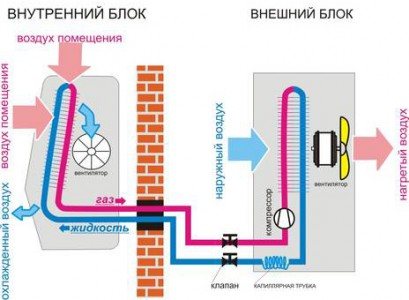

Today split systems are equipped with a remote control. It allows you to set the following modes:
- cooling,
- heating,
- ventilation,
- drying,
- night mode.
It is possible with the help of an automatic system to determine the temperature regime in the room and select the optimal operation of the split system. There is also a choice of fan operation. The equipment is equipped with a timer that allows you to turn it on and off at the right time. The curtains are also adjustable, and this makes it possible to direct the air masses in the desired direction.
Multisplit allows you to use several indoor units with one external unit. Each such device has its own separate remote control. Systems of this type are already equipped with special air filters.There are duct and wall multisystems, like air conditioners, only multisplits have great functionality and practicality.
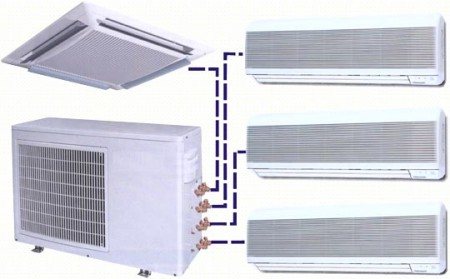

Split systems of cassette type
Such systems are installed under false ceilings. They can direct air only in three directions, and cooled air enters the room through the lower part of the indoor unit. Cassette split systems are powerful and distribute air masses evenly in the room.
The main advantages of such a unit include the fact that it is practically invisible and will not violate any design incarnations. Do not forget about saving electricity, since you can use only one unit of this type indoors and it will be enough, of course, if the space itself is not too large. It is very convenient to use such an air conditioning system in the bedroom. It is practically silent and distinguished by its functionality.
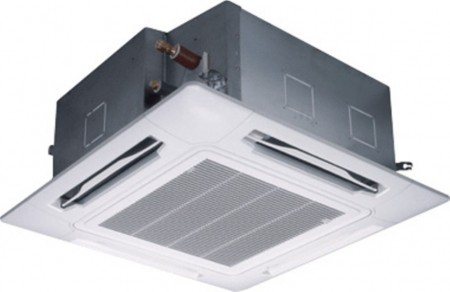

Models of air conditioners in a country house or cottage
There are more than two hundred multi split systems on our website. The variability of indoor units is almost limitless. It is difficult to call a particular external unit of a multi-zone air conditioner or a set of a duct air conditioner “the best”: it all depends on the terms of reference for the creation of an air conditioning system. In our work, we try to proceed from the technical characteristics, and also offer several options for the client to choose: for a different budget.
Nevertheless, we strongly recommend to our clients several manufacturers, proven over the years: all are native Japanese with a history of creating professional equipment, with their own developments. The product line of each of them allows you to choose an air conditioner for a house, a cottage for a different budget.
| Ranking place | Manufacturer | Country of origin | Country of Origin |
Installation of air conditioning systems
After you have chosen the air conditioning system at home, you need to proceed to the steps to install it. It is best to turn to specialists for help, who will not only install, but also configure the system.
Initially, you need to measure the size of the system that will be inside. If this is a split system, then the outdoor unit also needs to be measured. By such actions, the place for the installation of air conditioning systems at home is clearly determined.
The fasteners for mounting outdoor units must be strong. There are special enterprises that manufacture them, and I guarantee strength and durability. Fasteners are represented by metal structures of various sizes. There is an opportunity to choose the best option.
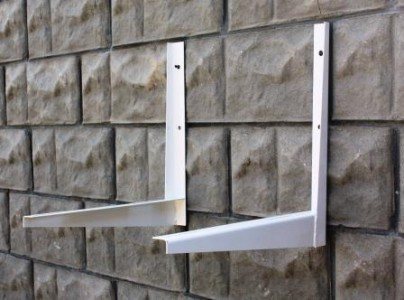

In order for the air conditioning system to work smoothly, you need to correctly install it: prevent bends in the pipes through which the freon is supplied. If you do not follow this rule, then freon may leak out and the unit will stop working.
All brands of modern air conditioners and split systems are almost identical in the installation process, but each system has its own nuances. If you install the outdoor unit of the air conditioner on the terrace, then you need to take into account that condensation from a special tube will constantly drain to the floor. To avoid this, it is best to enlarge the condensate drainage hose itself to the required size and lead it outside the terrace or other room.


Air conditioning a private house is a very simple process. It consists only in choosing the right system based on your preferences and needs. There are a huge variety of air conditioners and split systems that differ not only in cost, but also in their functionality.
Installation of air conditioners
In the overwhelming majority of cases, the installation of an air conditioner in a country house occurs at the stage of repair. This is a classic two-step editing.It consists in the fact that initially a specialist comes to your site for inspection, determining the customer's requirements on the spot with the aim of further drawing up the most complete commercial proposal. At the first stage, the supply of equipment is carried out, the laying of communication routes in a gutter in the wall or along the ceiling, drainage into the sewer of the house, and other general construction work. Next, we await the completion of your repair and when all the finishing work has already been completed, upon your call, we proceed to the installation of the indoor units of air conditioners, evacuation, test run and adjustment of the air conditioning system.
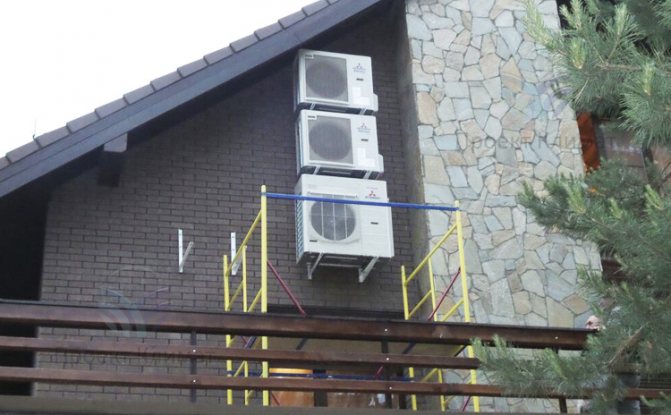

Installation of Mitsubishi Electric air conditioning system in a country house.


An example of the installation of duct air conditioners with the laying of air ducts and routes.
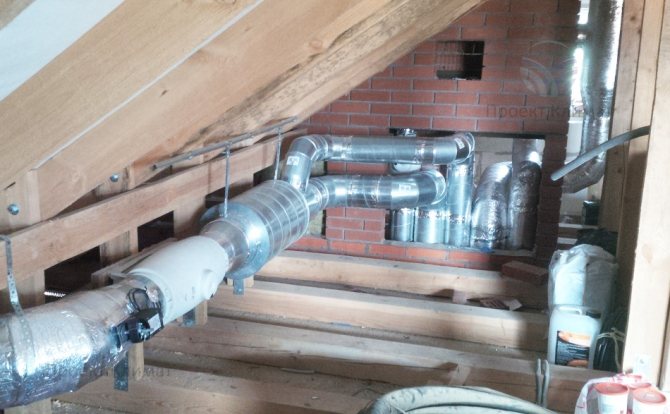

Small ventilation system in a private house. Accommodation in the attic.
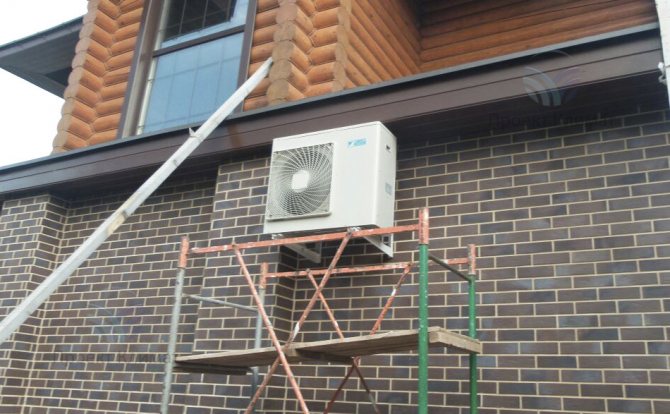

Installation of a multi split system in a country house with high-rise work from tours.
As a rule, when creating an air conditioning system, ventilation of a country house is also implemented. This is a slightly more difficult task, which necessitates the departure of not only the measurer, but also the engineer, the designer to the facility. Next, the calculation of the air exchange of all rooms is carried out, the air ducts are calculated, taking into account the characteristics of the building and design solutions, a draft of the ventilation system of a country house is created, where the bindings of each element are displayed, the selection of equipment is performed both in terms of technical parameters and at a cost that satisfies the customer.
If the air conditioner is responsible for cooling or heating the air inside the room, then the ventilation system provides its inflow and exhaust, creating a more comfortable living environment.

